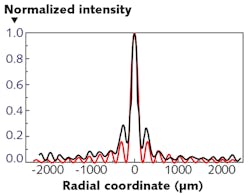With their nondiffracting and self-healing properties, Bessel-like beams find use in particle guiding, microprocessing, and other applications. Forming axicon lenses on the ends of optical fibers offers a compact way to generate Bessel-like beams without the alignment and stability issues that arise with bulky optical systems. However, previous fiber-based microaxicons produced Bessel-like beams with only several concentric rings (less than five, and with low quality), and other fiber-based methods produce the beams either with low quality or with narrow wavelength range. Now, researchers at Fudan University (Shanghai, China) have developed a novel and efficient approach to generating Bessel-like beams by fabricating self-growing polymer microtips at the facet of single-mode fibers. The method promises an effective, low-cost, convenient, and ultracompact method for generation of Bessel-like beams.
First, a dose-reduction photopolymer droplet is deposited at a precise location on the facet of a fiber to fabricate the creation of a short microtip with optimized shape. The fiber-based microtips can then be tailored by green laser power (of on the order of a microwatt) coupled into the other end of the fiber, laser exposure time (on the order of a minute), and diffused oxygen concentration, enabling all-fiber, high-quality Bessel-like beam conversion. Distributing oxygen in the convex droplet inhibits polymerization when the irradiated laser power is low and can naturally polish the end of the microtip to form a microaxicon. The resulting microtip functions over a broad bandwidth and produces Bessel-like beams with a maximum of more than 30 concentric rings. The researchers verified the self-healing properties of the beams. Reference: J. Tan, R. Yu, and L. Xiao, Opt. Lett. (2019); https://doi.org/10.1364/ol.44.001007.
About the Author
John Wallace
Senior Technical Editor (1998-2022)
John Wallace was with Laser Focus World for nearly 25 years, retiring in late June 2022. He obtained a bachelor's degree in mechanical engineering and physics at Rutgers University and a master's in optical engineering at the University of Rochester. Before becoming an editor, John worked as an engineer at RCA, Exxon, Eastman Kodak, and GCA Corporation.

